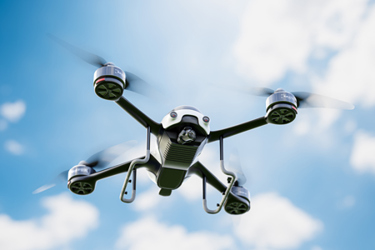Soaring Above Challenges: Drone-Based Inspection And Maintenance Take Off
By Christian Bonawandt

While drones first gained popularity among tech-forward hobbyists and video producers, they have since found use across various industries — including water and wastewater — to simplify asset management and O&M.
Drinking water and wastewater utilities have long struggled to do more with less, be it workforce or budget. Gradually over the past decade or so, drone technology has begun to emerge as a valuable tool to do exactly that. Aerial, aquatic, and ground-roving drones allow operators to make observations efficiently while reducing physical risk. In addition, they can inspect difficult or dangerous areas without putting a human in harm’s way. This is paying major dividends when it comes to inspection and maintenance tasks, providing utilities with efficient, cost-effective, and technologically advanced solutions. As drone technology continues to evolve, its adoption in the water sector is propelled by a host of advances that enhance the industry’s ability to monitor, assess, and maintain critical infrastructure.
Advances In Drone Technology
Drones have evolved significantly over the years. Once flimsy devices with simple cameras, many boast robust frames and an array of high-end gadgets. Some of the critical advancements include:
- Precision imaging and sensors. Today’s drone imaging technologies allow utilities to capture high-resolution imagery and employ specialized sensors for detailed inspections. Optical and thermal cameras, LiDAR sensors, and even water quality sensors provide a comprehensive view of infrastructure conditions, enabling utilities to identify potential issues such as leaks, structural damage, and variations in water quality.
- Autonomous navigation. The integration of autonomous navigation systems enables drones to follow predefined routes or adapt to changing environments during inspections. This feature is particularly beneficial when assessing expansive water infrastructure, as drones can navigate complex terrains, hover over waterbodies, and cover large areas efficiently, reducing the time and resources required for manual inspections.
- Ground drones for challenging terrains. In addition to airborne drones, ground-based drones are gaining prominence, especially for water utilities burdened by challenging terrain. These rolling drones can navigate through rugged landscapes, inspecting pipelines and infrastructure in areas that are difficult to access. Equipped with advanced sensors, these ground drones contribute to a comprehensive inspection strategy.
- More durable designs. Physical resilience is crucial in emergency response situations, where the ability to assess damage quickly and reliably can make a significant difference in mitigating the impact of incidents such as leaks or natural disasters. Drone manufacturers have developed products with impact-resistant polymers, reinforced frames, and corrosion-resistant coatings to enhance longevity and improve performance in difficult applications. In addition, sealed electronics protect sensitive equipment from unexpected contact with water.
How Water Utilities Are Deploying Drones
Drones are transforming the way water utilities inspect infrastructure. Whether soaring above water treatment plants or swimming inside underground pipes, drones provide a level of visibility that was once logistically challenging. Utilities can now quickly identify corrosion or other structural issues without the need for extensive manual labor or disruptive shutdowns. In addition, many water utilities are employing drones for:
- Leak detection. The speed and agility of drones make them ideal for rapid leak detection. Those with thermal imaging cameras can identify temperature variations indicative of leaks, enabling utilities to address issues promptly and prevent further water loss.
- Vegetation management. Overgrown vegetation around water infrastructure can pose significant challenges. Drones equipped with LiDAR and high-resolution cameras can create detailed 3D maps of the terrain. Utilities can identify areas requiring maintenance, preventing vegetation-related disruptions and ensuring the integrity of their systems.
- Emergency response. In the event of natural disasters or critical infrastructure failures, drones can rapidly assess the extent of damage, providing real-time data to aid in decisionmaking. This capability improves the speed and efficiency of emergency responses, ultimately minimizing the impact on communities and the environment
Regulations Cause Turbulence
Drone use isn’t all fun and games. For aerial drones, the Federal Aviation Administration (FAA) has tight rules on usage.1 The Part 107 regulations, implemented in 2016, set forth guidelines for commercial drone operators, requiring them to obtain a remote pilot certificate, adhere to altitude and airspace restrictions, and conduct flights within visual line of sight, among other stipulations. Commercial drone operators are required to keep certain records related to their operations, such as maintenance logs and flight records.
To overcome this, many utilities are turning to consulting and service companies that offer drones as a service. Such firms absorb liability, training, certification, maintenance, and other costs, allowing water utilities to pay for the use of drones and the data collected from them on an as-needed basis.
As water and wastewater utilities continue to embrace drone technology, the industry is experiencing a paradigm shift in inspection and maintenance practices. The combination of advanced features, including precise imaging, autonomous navigation, and other capabilities, equips utilities with powerful tools to address challenges proactively.
References:
 About The Author
About The Author
Christian Bonawandt is an industrial content writer for Water Online. He has been writing about B2B technology and industrial processes for 23 years.
